Abstract
Microgrids are defined as an interconnection of several renewable energy sources in order to provide the load power demand at any time. Due to the intermittence of renewable energy sources, storage systems are necessary, and they are generally used as a backup system. Indeed, to manage the power flows along the entire microgrid, an energy management strategy (EMS) is necessary. This paper describes a microgrid energy management system, which is composed of solar panels and wind turbines as renewable sources, Li-ion batteries, electrical grids as backup sources, and AC/DC loads. The proposed EMS is based on the maximum extraction of energy from the renewable sources, by making them operate under Maximum Power Point Tracking (MPPT) mode; both of those MPPT algorithms are implemented with a multi-agent system (MAS). In addition, management of the stored energy is performed through the optimal control of battery charging and discharging using artificial neural network controllers (ANNCs). The main objective of this system is to maintain the power balance in the microgrid and to provide a configurable and a flexible control for the different scenarios of all kinds of variations. All the system’s components were modeled in MATLAB/Simulink, the MAS system was developed using Java Agent Development Framework (JADE), and Multi-Agent Control using Simulink with Jade extension (MACSIMJX) was used to insure the communication between Simulink and JADE.
1. Introduction
Hybrid renewable energy systems or multiple energy resources systems, popularly known as microgrid power systems, are a new generation of electrical sources providing balanced and clean electricity. Photovoltaics (PVs) and wind turbines are renewable power technologies widely used in most regions on earth, and are two of the cleanest forms of energy conversion available [1]. The hybridization of different sources of energy aims, on one hand, to provide sustainable and balanced electricity in remotes areas, and on the other hand, to ensure maximum electricity generating capacity with the lowest cost for the areas served by conventional power grids [2]; however, the intermittent nature of renewable energy sources and their dependency on metrological conditions can cause some problems, especially in terms of storage. Therefore, an energy management system, or EMS, is necessary to control the power flow. The EMS defined by the International Electrotechnical Commission in the standard IEC 61970 as a computer system comprising a software platform providing basic support services and a set of applications providing the functionality needed for the effective operation of electrical generation and transmission facilities, so as to ensure adequate security of energy supply with a lowest cost [3]. In addition, the EMS of microgrid systems is an output of those features. It is always equipped with decision-making algorithms, helping the EMS to optimize microgrid operation.
Generally, in the literature, EMS control is categorized into two types: centralized EMS and decentralized EMS [4]. Centralized control schemes include a central power controller configured to control the distribution of electrical power to a microgrid. The main objective of this is to optimize conflicts and to apply easily algorithms during operation due to higher-level decisions, and all information from the distributed energy sources and from the load demand is sent to the central controller [5]. Nevertheless, some problems appear when the system becomes bigger and more complex, which requires more powerful servers in order to manage large amounts of data; additionally, to implement the system management in real time, any simple change in the system necessitates an update of the centralized EMS strategy, and if there is any washout in the main server, the whole system collapses [6]. The decentralized EMS strategy aims to attain the optimal operation mode of the microgrid while providing the highest possible autonomy to the different sources. This can be achieved by connecting each energy source to its proper controller in order to optimize the energy generation independently of all sources [7]. In recent years, decentralized approaches have been successfully implemented in microgrids [8,9]. The main advantage of decentralized EMS architecture is that partially managed microgrid operation is much higher in cases of dysfunction of the different components. In addition, due to the recent development of microcontrollers and the important decrease in their cost, decentralized EMS architecture is the most suitable technology to adopt for the lowest investment cost in comparison with a centralized approach. Decentralized approaches have also been primarily addressed in the technical literature using the multi-agent systems (MAS) framework. An energy management system based on intelligent MAS for microgrid systems was proposed in [10]; it maintains power balance between the loads and the energy sources, using the predictions of PV generation, wind generation, and load demand in order to supply the required load.
In [11], Boudoudouh and Maâroufi proposed an MAS for the energy management of a microgrid system. The simulations were run using MATLAB-Simulink and Java Agent Development (JADE) software. The reliability of this model was validated by fulfilling requirements such as its autonomy and its flexibility in a way that any changes made could not disrupt the whole control strategy system.
Another MAS was proposed in [12] for a microgrid system in order to achieve the optimum utilization of distributed sources with the maximal level of production using renewable sources and optimum diesel consumption.
An MAS for the real-time operation of a microgrid was investigated in [13], which proposed an operational strategy mainly focused on generation scheduling and demand-side management. The above-mentioned studies demonstrate the beneficial applications of MAS in microgrids. In this paper, an energy management system for microgrid systems based on the maximization of renewable sources is implemented using the MAS approach, and the bidirectional DC/DC converter was controlled using ANNC.
Indeed, the main objective of this system is to maintain the power balance in the microgrid and to provide a configurable and flexible control for both demand variations of the load and the renewable energy sources. The rest of this paper is organized as follows. The microgrid system is discussed in Section 2. Multi-agent frameworks and energy management systems are presented in Section 3. Section 4 discusses the results of the simulation. This paper ends with a conclusion.
2. Microgrid System
A microgrid is a hybrid energy system consisting of multiple energy sources, energy management, storage system, loads, and able to be operated independently or with the electrical grid. The proposed microgrid shown in Figure 1 consists of two renewable sources, a photovoltaic system and a wind system, connected to a battery storage system and the electrical grid as a backup source. Therefore, the renewable sources are used as the main energy sources, and due to their dependency on meteorological conditions, the grid and the battery are assigned as backup power sources to continually satisfy the load, which means that the battery storage system will be used as a power source when the renewable sources are not able to satisfy the load demand, and as a load when they have enough power and store the excess power to keep the system balanced. The grid power source will be used rarely due to the high price of grid electricity. It will be used in two cases, as a power source when the renewable sources are not enough to satisfy the load demand and the battery state of charge is less than 20%, and the second utilization is as a load to balance the power of microgrid bus when it has enough power and the battery state of charge is more than 80%.
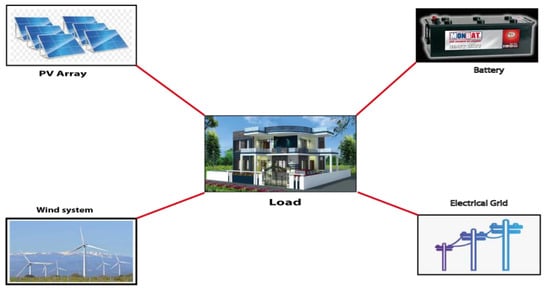
Figure 1.
Microgrid systems.
As we can see from Figure 1, the microgrid system consists of several power sources, and each source is modeled independently, as explained in the rest of this section.
2.1. Photovoltaic System
The photovoltaic system consists of a PV panel, a boost converter, and an MPPT controller, as shown in Figure 2.
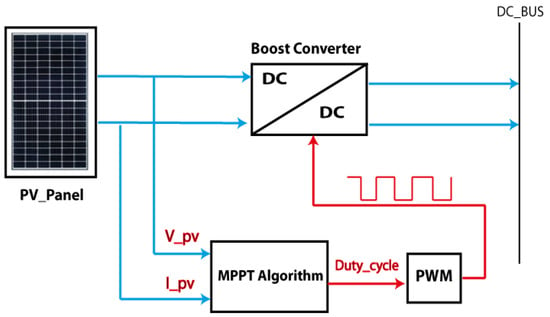
Figure 2.
Solar conversion system with a controller.
The MPPT algorithm in the photovoltaic system keeps the voltage of the panel close to the equivalent voltage of the maximum power point. There are several algorithms for the MPPT control of PV panels [14]; in this study, the used method was P&O due to its simplicity and its facility during implementation to determine the required change in duty cycle based on the change value of power and voltage at each time. Figure 3 shows the flowchart of the MPPT algorithm.
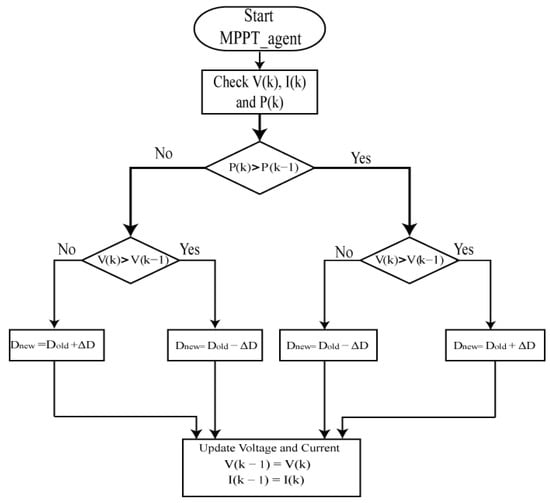
Figure 3.
Flowchart of the P&O MPPT algorithm.
2.2. Wind System
The wind energy conversion system consisted of wind turbines, a boost converter, a diode rectifier, a permanent magnet synchronous generator (PMSG), and an MPPT controller.
The MPPT controllers can be easily implemented on the DC–DC converter, as shown in Figure 4 below. The power is extracted from the wind (Pw) as a function of the air density (ρ) and the wind speed (v).
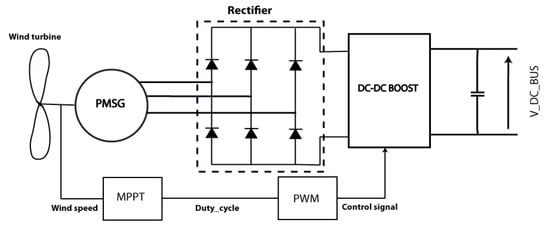
Figure 4.
Wind system with a controller.
The PMSG is coupled directly to the wind turbine; a three-phase diode bridge is employed to rectify the generated output voltage. A DC-DC boost is used to implement the P&O algorithm to track the maximum power point.
2.3. Battery Storage System
The battery storage system consisted of a Li-ion battery and a bidirectional DC–DC converter. This converter is responsible for maintaining and stabilizing the DC–Bus voltage through an ANNC controller, as observed in Figure 5 [15].

Figure 5.
Battery storage system with a controller reprinted with permission from [15] Copyright 2020 Wiley.
As discussed before, lithium-ion batteries are the preferred power source for many storage system applications due to the advantages compared to other battery types. Despite all advantages of Li-ion batteries, they need special care because unlike other types, they contain a volatile, extremely flammable solvent that will burn quite vigorously and easily.
Over-charging/discharging is the main reason behind most accidental Li-ion battery explosions. Therefore, a battery management system is important for the safe operation of Li-ion batteries as shown in Figure 6. It is always complicated to model those kinds of systems because of the nonlinearity of battery voltage responses. In this paper, we used the dynamic battery model from the SimPowerSystems library of MATLAB/Simulink [16,17]. The main task of the battery energy storage system in this study was to stabilize the voltage at the DC_Bus. The next flowchart shows the control strategy of the battery system.
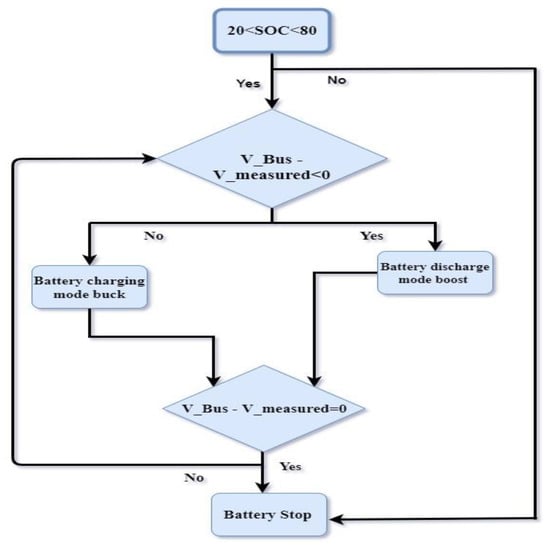
Figure 6.
Control strategy of the battery energy system.
The battery state of charge (SOC) represents the fundamental challenge of battery management systems (BMSs), which represents the residual capacity of the battery. However, this state is not directly measured [18]. For this reason, several methods to estimate SOC have been proposed in the literature [18,19]. In this work, we used an ANN model to estimate the battery state of charge, due to its effectiveness and robustness compared to other methods. Figure 7 shows the used architecture of the ANN model to estimate the battery state of charge.
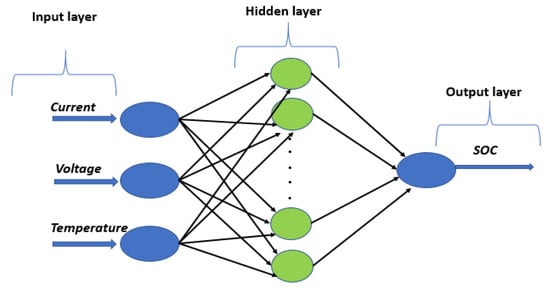
Figure 7.
ANN model for state of charge estimation.
The details of the design steps of the ANN model have been described clearly in our previous work [19]. The Li-ion battery was connected to the DC_BUS throughout the DC–DC bidirectional convert in order to keep the voltage equal to the reference value mentioned in the bus using charging and discharging modes.
The converter used in this work was a half-bridge IGBT topology, operating in continuous conduction mode (CCM). The converter operated in boost mode for discharging the battery, and in buck mode for storing the surplus energy at the DC_Bus. In boost mode, S2 and D1 are active and the current flows to the DC_Bus. In buck mode, S1 and D2 are active and the power flows to the battery.
- ➢ Buck Mode
When the voltage at DC_BUS exceeds the desired value, the BDC works as a buck converter and the energy flows from the DC_BUS to the battery.
Step1.a: S1 turned ON and S2 OFF
This steep time interval is between [zero and Ton] of each pulse control cycle. The energy flows to the battery through S1, as shown in Figure 8, and the battery voltage is:
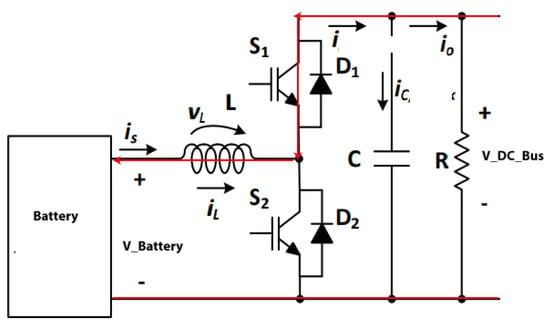
Figure 8.
Converter in charging mode Step1.a.
Step 1.b Ton: T: S1 and S2 turned OFF
This steep time interval is between [Ton and T] of each pulse control cycle. The energy flows to the battery through D2, as shown in Figure 9, and the battery voltage is:
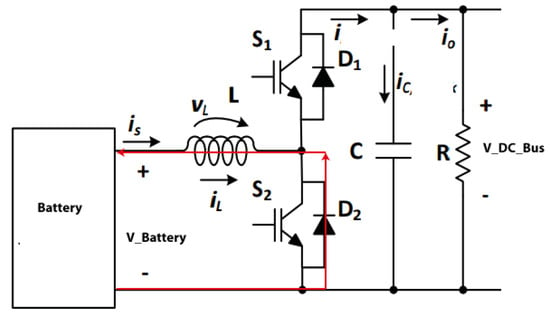
Figure 9.
Converter in charging mode Step1. b.
- ➢ Boost Mode
When the voltage at DC_BUS is less than the desired value, the BDC works as a boost converter and the energy flows from the battery to DC_BUS.
Step2.a: S1 turned OFF and S2 ON
This steep time interval is between [zero and Ton] of each pulse control cycle. The energy flows to the DC_BUS through S2, as shown in Figure 10; in this case, the battery voltage is:

Figure 10.
Converter on discharging mode Step2.a.
Step2.b: S1 turned OFF and S2 OFF
This steep time interval is between [Ton and T] of each pulse control cycle. The energy flows to the DC_BUS through D1, as shown in Figure 11, and the battery voltage is:
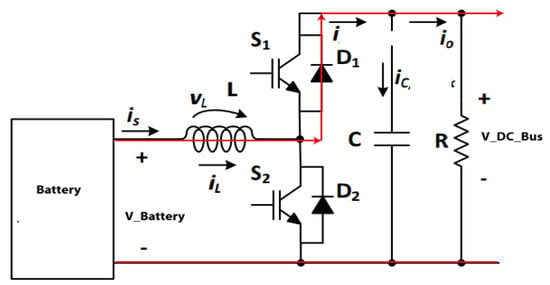
Figure 11.
Converter on discharging mode Step2.b.
The ANNC used in this paper is known by two names: feedback linearization control, when the plant model has a particular form; and NARMA-L2 control, when the plant model is estimated by the same form. The main objective of this type of control is to linearize the nonlinear dynamics. The NARMA L2 controllers are composed of two neural networks: the first neural network is the NARMA model, which is the standard model used to represent general discrete-time nonlinear systems to identify which should be controlled; and the second network aims to generate the control signal, as Figure 12 shows. The mathematic equations of ANNC are well explained in our previous publication [15].
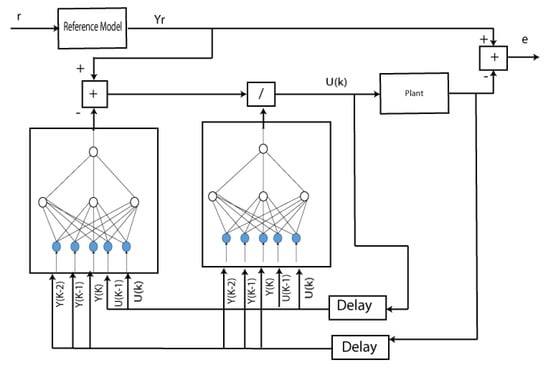
Figure 12.
ANNC controllers for DC-DC converter.
3. Multi-Agent Framework and Energy Management System
3.1. Multi-Agent Framework and Co-Simulation MATLAB/JADE
Multi-agent systems are a specific type of distributed smart systems in which independent agents inhabit a world with no global control [20]. An MAS is also known as a collection of independent computational agents, which can be powerful in large applications performing tasks based on goals in an environment that cannot easily be defined in an analytical way [21]. The parallelism in agents’ interaction is the main advantage of MAS. Therefore, to overcome the problem of S-function of MATLAB Simulink in the processing of parallelism system, the authors of [22] have proposed the MacsimJX platform. The focus of this paper is on the control of all system converters using a multi-agent framework. Five agents are used: PV MPPT agent, wind MPPT agent, load agents, battery agent, and electrical grid agent. A description of each agent’s task presented in Table 1.

Table 1.
Task description of system agents.
A real model of each device of the microgrid system is required to manage the power flow at the microgrid. Therefore, each entity in the studied microgrid was modeled under MATLAB Simulink, as described in Section 2.
The MAS was developed under (Java Agent DEvelopment Framework) JADE, a software framework for the development of agents, implemented in Java [23,24]. In order to establish the communication between MATLAB/Simulink and JADE, the interface MacsimJX was used. This is an extension of MACSim, initially built to allow systems designed with MATLAB to be controlled by agents operating in an external program. This tool authorizes systems modeled in MATLAB/Simulink to exchange data with agent systems which are created using Jade, as shown in Figure 13 [25].
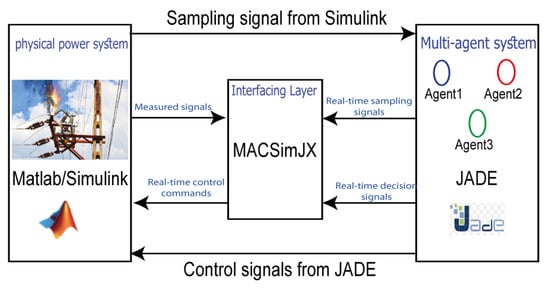
Figure 13.
Simulink and JADE co-simulation reprinted with permission from [25]; Copyright 2020, Sage.
3.2. Energy Management System
The studied system in this work consisted of two renewable energy sources (a photovoltaic solar system, and wind turbine), fueling a DC bus to supply loads connected to DC_BUS. In addition, the backup system was composed of a Li-ion battery for energy storage and the electrical grid, as shown in Figure 14. The objective while managing the system was to supply the load demand and maintain the power balance at the DC_BUS by sizing all sources to supply the load demand. Moreover, the DC_BUS voltage was maintained around the reference voltage value by calculating the difference between them. The battery system is responsible for the maintenance of the voltage value around the required value by charging and discharging throughout the bidirectional DC-DC converter.
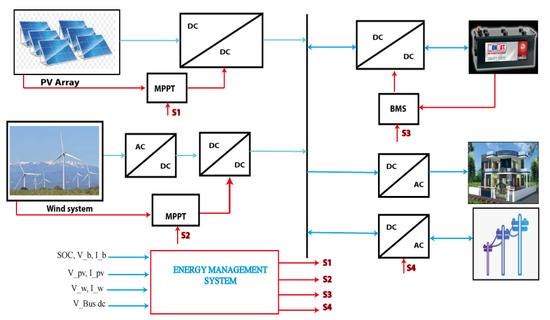
Figure 14.
Proposed energy management system.
The microgrid controller agent manages this heterogeneous feature of the microgrid. It receives the difference between the RES power production of each source and the consumption load from Simulink. Then, it checks the signal sign: if the signal sign is positive, the battery agents react in order to consume the excess energy in conditions where the battery state of charge is less than 80%; if this is not the case, the battery agent will send a signal to the grid agent and the surplus will be directed into the electrical grid. On the other hand, if the signal sign is negative, the PV agent and wind turbine agent will react in a way to provide energy to control the load demand in the microgrid by the use of one source or a combination of several renewable sources. In addition, if the renewable sources are not enough to cover the demanded power, the battery agents receive the information to provide the energy to the microgrids. However, the battery will act only if the state of charge is more than 20%, which is the safest case of utilization, but if the SOC is less than 20%, the grid agent will receive the order to provide the requested energy. The EMS strategy proposed in this study is shown in the flowchart of Figure 15.
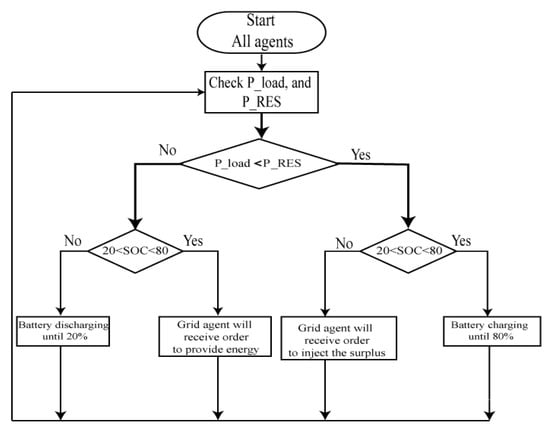
Figure 15.
Energy management strategy.
4. Results and Discussion
Table 2 presents a description of the studied small hybrid wind–solar battery. The electricity produced by the renewable sources is not stable over time due the intermittence of these systems. As a result, two different modes of processing appear, the surplus and the lack of energy at the DC_BUS. The simulation ran for 7 s with 1 × 10−5 sampling time, in order to present the voltage and the power at the DC_Bus for different values of solar irradiation and wind speed, as Figure 16 and Figure 17 show. In the following section, the reaction of each element to the different variations is presented.

Table 2.
Microgrid component specification.
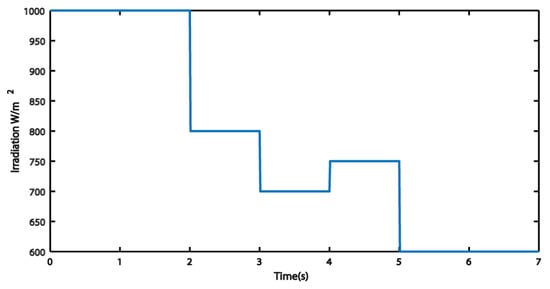
Figure 16.
Solar irradiation scenario (W/m2).
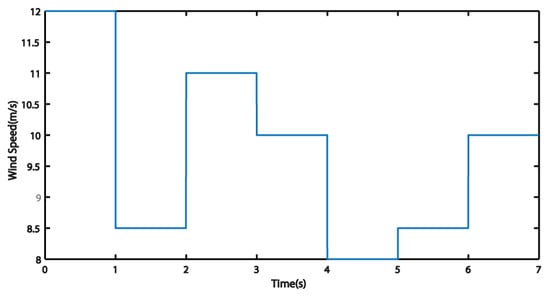
Figure 17.
Wind speed scenario (m/s).
At the beginning of the simulation, shown in Figure 18 and Figure 19, the PV power produced was about 14 KW and the wind power was about 6 KW, which means that a surplus of 5 KW in the DC_BUS will be stored in the battery, because the battery SOC value in the safe zone is around 70%. Therefore, as Figure 20 and Figure 21 show, the increase in the state of charge curve and the battery power equal to −5 KW mean that the battery is receiving an amount of energy around 5 KW. Therefore, the surplus problem in the DC_BUS is fixed. In addition, between the times 0 and 4 s, the battery charges with a multiple slope-charging curve, which decreases over time, due to the reduction in the difference between the demanded and the produced power over time. The initial SOC = 70% increased when the difference was positive, as can be seen in the time interval between zero and four seconds, and decreased between four and six seconds with two discharging slope-curves; notably, the difference between the produced and the required power was almost equal to −2 KW between 4 and 5 s, and −4 KW between 5 and 6 s. However, the battery will provide this lack of power, as shown in Figure 20 and Figure 21. The increase in SOC and the battery power was about 2 KW between 4 and 5 s, and in a parallel way, about 4 KW between 5 and 6 s, which indicates the provided power at this time.
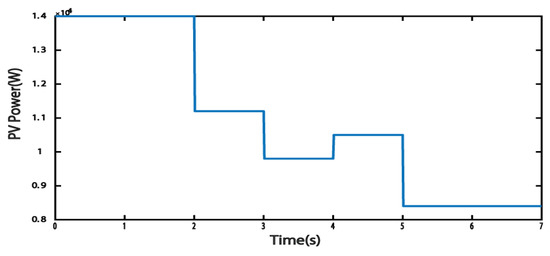
Figure 18.
Solar power produced during the irradiation scenario.
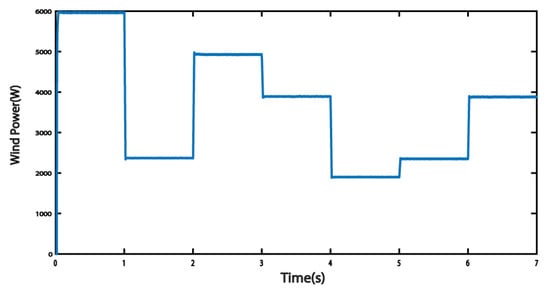
Figure 19.
Wind power produced during the wind speed scenario.
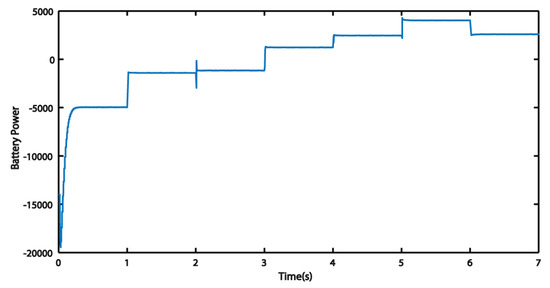
Figure 20.
Battery power (W) produced during the proposed scenario.
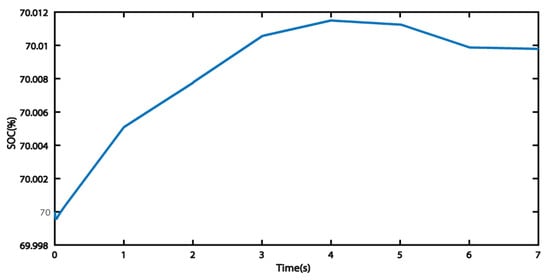
Figure 21.
Battery state of charge during the proposed scenario.
As mentioned at the beginning of this paper, this study aims on one hand to cover the load power by balancing the amount of energy in microgrid systems, and on the other hand to stabilize the voltage at the DC_BUS. Figure 22 and Figure 23 show the comparison made between the voltage and the power in the latter scenario; the obtained results explain the effectiveness and robustness of our technique against all changes in meteorological conditions.
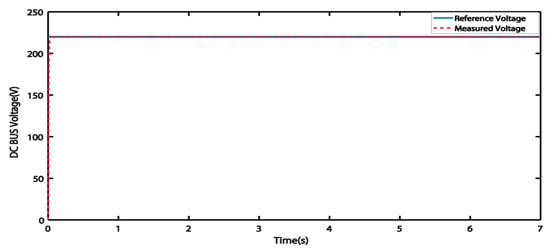
Figure 22.
Comparison between measured DC_Bus voltage and the reference voltage.
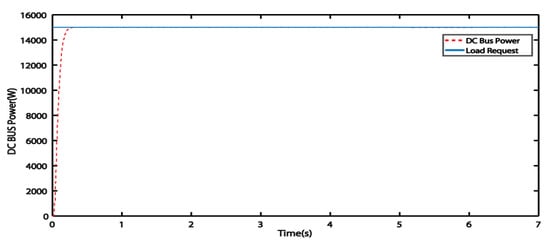
Figure 23.
Comparison between the load power request and system power produced.
5. Conclusions
This paper has presented the structure and composition of an energy management system based on renewable energy resources. The balance of power and the stabilization of voltage at the DC_BUS were the main objective of this work. Decentralized control by MAS was proposed in this paper to overcome the limitations of existing centralized methods.
The battery state of charge in this paper was estimated using an artificial neural network based on a generated database using several tests at MATLAB/Simulink. Finally, the software JADE was used for the agent’s development, and the platform MacsimJX was used for linking between MATLAB/Simulink and JADE, in order to avoid the problem of the unstable nature of S-functions with a multithread process.
Author Contributions
Conceptualization, Y.B. and A.J.A.; methodology, Y.B.; software, Y.B.; validation, Y.B., M.A. and H.E.M.; formal analysis, Y.B.; investigation, Y.B.; resources, T.L.; data curation, A.A.; writing—original draft preparation, Y.B.; writing—review and editing, A.A. and A.A.; visualization, Y.B.; supervision, A.A. and H.E.M.; project administration, H.E.M. and T.L.; funding acquisition, A.J.A., R.J., N.O. and A.A. All authors have read and agreed to the published version of the manuscript.
Funding
The authors extend their appreciation to the deputyship for Research & Innovation, Ministry of Education in Saudi Arabia for funding this research work through the project number (IFP-2020-13).
Institutional Review Board Statement
Not applicable.
Informed Consent Statement
Not applicable.
Data Availability Statement
Not applicable.
Conflicts of Interest
The authors declare no conflict of interest.
References
- Gerlach, A.-K.; Stetter, D.; Schmid, J.; Breyer, C. PV and wind power-complementary technologies. In Proceedings of the 26th European Photovoltaic Solar Energy Conference, Hamburg, Germany, 5–9 September 2011. [Google Scholar]
- Rekioua, D. Hybrid Renewable Energy Systems: Optimization and Power Management Control; Springer Nature: Basingstoke, UK, 2019. [Google Scholar]
- Singh, A.R.; Lei, D.; Kumar, A.; Singh, R.; Meena, N.K. Microgrid system. In Microgrid: Operation, Control, Monitoring and Protection; Springer: Singapore, 2020; pp. 1–25. [Google Scholar]
- Cheng, Z.; Duan, J.; Chow, M.-Y. To centralize or to distribute: That is the question: A comparison of advanced microgrid management systems. IEEE Ind. Electron. Mag. 2018, 12, 6–24. [Google Scholar] [CrossRef]
- Meng, L.; Sanseverino, E.R.; Luna, A.; Dragicevic, T.; Vasquez, J.C.; Guerrero, J.M. Microgrid supervisory controllers and energy management systems: A literature review. Renew. Sustain. Energy Rev. 2016, 60, 1263–1273. [Google Scholar] [CrossRef]
- Karavas, C.S.; Kyriakarakos, G.; Arvanitis, K.G.; Papadakis, G. A multi-agent decentralized energy management system based on distributed intelligence for the design and control of autonomous polygeneration microgrids. Energy Convers. Manag. 2015, 103, 166–179. [Google Scholar] [CrossRef]
- Rodriguez, R.J.; Zeller, R.J.; Skertic, R.J.; Dougherty, M.P.; Cline, C.H. Micro Grid Control System. U.S. Patent No. 10,530,163, 7 January 2020. [Google Scholar]
- Sood, V.K.; Ali, M.Y.; Khan, F. Energy management system of a microgrid using particle swarm optimization (PSO) and communication system. In Microgrid: Operation, Control, Monitoring and Protection; Springer: Singapore, 2020; pp. 263–288. [Google Scholar]
- Gao, H.; Xu, S.; Liu, Y.; Wang, L.; Xiang, Y.; Liu, J. Decentralized optimal operation model for cooperative microgrids considering renewable energy uncertainties. Appl. Energy 2020, 262, 114579. [Google Scholar] [CrossRef]
- Bogaraj, T.; Kanakaraj, J. Intelligent energy management control for independent microgrid. Sādhanā 2016, 41, 755–769. [Google Scholar] [CrossRef] [Green Version]
- Boudoudouh, S.; Maâroufi, M. Multi agent system solution to microgrid implementation. Sustain. Cities Soc. 2018, 39, 252–261. [Google Scholar] [CrossRef]
- Aung, H.; Khambadkone, A.; Srinivasan, D.; Logenthiran, T. Agent-based intelligent control for real-time operation of a microgrid. In Proceedings of the 2010 Joint International Conference on Power Electronics, Drives and Energy Systems & 2010 Power India, New Delhi, India, 20–23 December 2010. [Google Scholar]
- Logenthiran, T.; Srinivasan, D.; Khambadkone, A.M.; Aung, H.N. Multiagent system for real-time operation of a microgrid in real-time digital simulator. IEEE Trans. Smart Grid 2012, 3, 925–933. [Google Scholar] [CrossRef]
- Hlaili, M.; Mechergui, H. Comparison of different MPPT algorithms with a proposed one using a power estimator for grid connected PV systems. Int. J. Photoenergy 2016, 2016, 1728398. [Google Scholar] [CrossRef] [Green Version]
- Boujoudar, Y.; Azeroual, M.; El Moussaoui, H.; Lamhamdi, T. Intelligent controller based energy management for stand-alone power system using artificial neural network. Int. Trans. Electr. Energy Syst. 2020, 30, e12579. [Google Scholar]
- Tremblay, O.; Dessaint, L.-A.; Dekkiche, A.-I. A generic battery model for the dynamic simulation of hybrid electric vehicles. In Proceedings of the 2007 IEEE Vehicle Power and Propulsion Conference, Arlington, TX, USA, 9–12 September 2007; pp. 284–289. [Google Scholar]
- Tremblay, O.; Dessaint, L.-A. Experimental validation of a battery dynamic model for EV applications. World Electr. Veh. J. 2009, 3, 289–298. [Google Scholar] [CrossRef] [Green Version]
- Boujoudar, Y.; Elmoussaoui, H.; Lamhamdi, T. Lithium-Ion batteries modeling using NARX Nonlinear model. In Proceedings of the 2019 International Conference on Wireless Technologies, Embedded and Intelligent Systems (WITS), Fez, Morocco, 3–4 April 2019. [Google Scholar]
- Boujoudar, Y.; Elmoussaoui, H.; Lamhamdi, T. Lithium-ion batteries modeling and state of charge estimation using artificial neural network. Int. J. Electr. Comput. Eng. 2019, 9, 3415–3422. [Google Scholar] [CrossRef]
- Oprea, M. Applications of multi-agent systems. In Information Technology; Springer: Boston, MA, USA, 2004; pp. 239–270. [Google Scholar]
- Habib, H.F.; Youssef, T.; Cintuglu, M.H.; Mohammed, O.A. Multi-agent-based technique for fault location, isolation, and service restoration. IEEE Trans. Ind. Appl. 2017, 53, 1841–1851. [Google Scholar] [CrossRef]
- Robinson, C.R.; Mendham, P.; Clarke, T. MACSimJX: A tool for enabling agent modelling with Simulink using JADE. J. Phys. Agents 2010, 4, 1–7. [Google Scholar] [CrossRef] [Green Version]
- Boudoudouh, S.; Maâroufi, M. Real-time battery state of charge estimation in smart grid application by multi agent system. Int. J. Hydrog. Energy 2017, 42, 19487–19495. [Google Scholar] [CrossRef]
- Bellifemine, F.; Poggi, A.; Rimassa, G. Developing multi-agent systems with a FIPA-compliant agent framework. Softw. Pract. Exp. 2001, 31, 103–128. [Google Scholar] [CrossRef]
- Azeroual, M.; Lamhamdi, T.; El Moussaoui, H.; El Markhi, H. Simulation tools for a smart grid and energy management for microgrid with wind power using multi-agent system. Wind. Eng. 2019, 44, 661–672. [Google Scholar] [CrossRef]
Publisher’s Note: MDPI stays neutral with regard to jurisdictional claims in published maps and institutional affiliations. |
© 2021 by the authors. Licensee MDPI, Basel, Switzerland. This article is an open access article distributed under the terms and conditions of the Creative Commons Attribution (CC BY) license (https://creativecommons.org/licenses/by/4.0/).